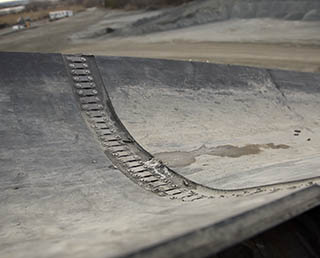Split Decision: Learn the Truth Behind Vulcanization vs. Heavy-Duty Mechanical Fastening
 June 5th, 2018
June 5th, 2018
Most belt conveyor operators know that when it comes to the critical issue of belt splicing, there are two primary options to consider – vulcanized splicing through heat or chemicals and mechanical fastening with metal hinges or plates. What they may not know are all of the factors that influence the decision and ultimately determine the success of the splice.
To help operators better understand the conditions that impact the decision, we’ve compiled a “True or False” quiz on vulcanization vs. mechanical fastening. Test your knowledge and conceptions of this critical process below:
1. You can’t repair higher tension belts with mechanical fasteners
False. With the use of synthetic carcass belts and improved fastener designs, mechanical fasteners are compatible with high-tension belts, with ratings of up to 2000 PIW.
2. Mechanical fasteners can prevent the sift through of carried materials
True. While vulcanized belts are ideal for the prevention of material sift-through, mechanical fastening may actually be preferable in many instances. If the splice is done properly, sifting should not be a problem. Solid plate splices can be sift-proof, and if filler tape is used with a bolt solid plate fastener, sifting is eliminated.
3. Mechanical fasteners are noisy, incompatible with belt cleaners and scrapers, and generally damage the belt
False. Conveyor belt damage, noise, and damage to the cleaner can all be avoided when mechanical splices are properly installed, maintained, and countersunk by skiving the belt.
4. Some belts are not well-suited to vulcanization
True. There are a number of conveyor belt conditions that can interfere with the ability to vulcanize. Older and/or worn fabric belts have weaker belt layers that will become brittle as heat is applied during vulcanization. Older rubber belts also present challenges as the bondable properties of rubber will deteriorate over time. Finally, some operations may not have sufficient belt length to vulcanize as the process will require some take-up to successfully complete.
5. My belt can be vulcanized anytime or anywhere
False. One of the primary challenges with vulcanization is the need for specific conditions to produce a proper splice. Vulcanization requires clean, dry, and relatively warm conditions to succeed. Multiple factors – including chemical residue, excessive moisture, and extreme temperatures – can interfere with the curing of the adhesives and cause nicks and/or bubbles. This will result in a weakened splice.
Additionally, vulcanizing can be very difficult in areas that aren’t easily accessible, further limiting the conditions conducive to the process.
6. Vulcanization will require notable downtime
True. In fact, vulcanization requires an operation to shut down the belt for a substantial amount of time – much longer than a mechanical splice would. The chemicals used in the process require several hours to cure, ensuring a minimum of eight hours of down time. Perhaps more significantly, vulcanization requires a trained professional that will likely have limited availability, determining when the work can ultimately be scheduled.
7. Vulcanization won’t compromise my belt strength
False. Even when done or completed properly, vulcanizing weakens the conveyor belt, removing an entire ply of strength. The effect is even more severe on improperly conducted vulcanizations. A mechanically fastened splice, however, does not compromise the belt’s integrity when installed correctly.
8. Vulcanized splice inspection can be difficult
True. It is nearly impossible for the naked eye to detect the early signs of adhesion breakdown in a vulcanized splice. Often, operators aren’t even aware that they are experiencing a problem until a vulcanized splice fails– a catastrophic event that requires the immediate shutdown of the line.
Conveyor belt and belt splice damage will always be a fact of life in most material-handling applications. While every splicing process has its limitations, belt conveyor operators can make more efficient decisions by better knowing all of the factors to consider when deciding between a vulcanized splice and the use of mechanical fastening.
Authored By: Aaron Rosso, Senior Product Manager
Rosso is responsible for managing the heavy-duty mechanical belt fastener program globally for Flexco, including the program vision and strategy, product development plan, product line portfolio, promotion, PR and communications, pricing, and profitability. Rosso graduated from Western Michigan University with a bachelor’s degree in Finance and received his master’s degree in business administration from the Kellogg School of Management – Northwestern University with a concentration in Marketing and Strategy.
Subscribe to the Flexco Blog
Published Date
June 05, 2018Product Group
- Mechanical Belt Fastening Systems
Issue
- Downtime
